Learn vocabulary to accompany the verb essere, to be.
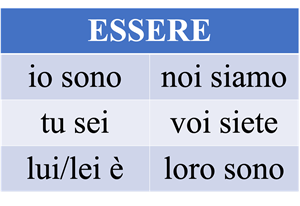
Learn how to conjugate the irregular verb essere in Italian. Student will learn how to make the verb form match the subject of the sentence.
Student will practice using the verb essere in the context of sentences in Italian. Student will change the verb form to match various subjects given.
Answers and explanations to essere verb activity 1
Student will practice translating subjects and verbs from English into Italian. The exercise will use full sentence context, but the student is only required to translate the subject and verb of each exercise.
Answers and explanations to essere verb activity 2
Student will learn basic animal vocabulary by repeating new words after the instructor. Instructor will also share animal sounds in Italian and how they differ from English.
Answers and explanations to matching activity for lesson 8
Student will learn about animals that are often found in Italy that are not as common in other countries of the world. Instructor will provide image references and describe how the animals relate to vocabulary already learned.
Students will combine several elements of what they have learned in the previous videos to complete a synthesis activity. The exercises will use animals and numbers.
Student will extend knowledge of animal vocabulary and learn to express his or her favorite animal using a new grammatical structure. This is simply and introduction to that structure, which will be covered in more detail in a later lesson.
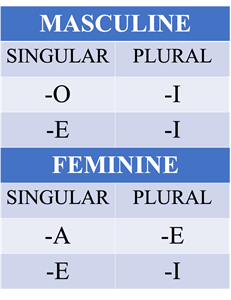
Student will learn about gender of nouns in Italian. Instructor will provide examples using vocabulary with which the student is already familiar.
Students will learn about number of nouns in Italian. Instructor will provide examples of singular and plural nouns using vocabulary with which the student is already familiar.
Answers and explanations to plurals activity for lesson 9
Students will learn how to use c'è and ci sono (there is, there are) to describe existential conditions of objects and people.
Student will use the synthesis activity from Lesson 8 to complete an extension exercise. Student will fill in the last blank for each question using the phrases c'è and ci sono.
Answers and explanations to synthesis activity for lessons 8 and 9
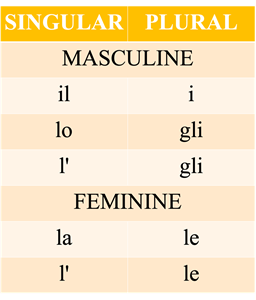
Student will learn about definite articles (referring to specific things or people) in Italian. Instructor will use examples with vocabulary words to put the articles in context.
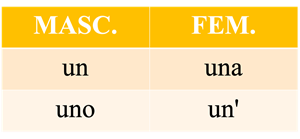
Student will learn about indefinite articles (referring to general things or people) in Italian. Instructor will use examples with previous vocabulary words to put the articles in context.
Answers and explanations to article matching activity for lesson 10
Instructor will present lesson vocabulary with focus on appropriate articles to accompany nouns. Student is encouraged to think about how to make each article and noun combination plural.
Student will learn the parts of the body in Italian by repeating new vocabulary after the instructor. A song will also be used to aid in retention of new words.
Answers and explanations of vocabulary retention activity (parts of the body)
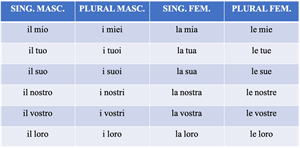
Instructor will begin with an explanation of possessive structures in English. Students will then learn how to express possession in Italian through a new possessive adjective structure.
Instructor will walk through a complete example of using possessive adjectives in order to demonstrate how their forms and functions change. Student is encouraged to take notes and follow along verbally with the exercise.
Student will complete a worksheet to practice using possessive adjective structures in Italian. Instructor will walk through an example to demonstrate proper thought process.
Student will complete exercises to cement the Italian possessive structures. The practice activity develops the student's ability to form complete sentences using the new grammar concept.
Answers and explanations to possession practices 1 and 2
Student will learn about Italian-English cognates, or words that are similarly spelled and/or pronounced between the two languages.
Student will practice identifying Italian-English cognates. Repetition with focus on pronunciation is particularly important when working with cognates, as it is easy to pronounce these words as if they were their English counterparts!
Instructor will warn against thinking all words that are similar between English and Italian are cognates. Student will work with several examples to understand the concept of "false friends."
Instructor will review lesson activity using cognates and false cognates prior to the student completing the worksheet on his or her own.
Answers and explanations to cognates activity for lesson 12
Instructor will read a series of sentences in Italian. Student will write down the sentences as he or she hears them. Following the activity, the student will also write down English translations.
Instructor will provide a comprehensive review of the listening activity. Student is encouraged to check spelling of Italian words using the answer key to the activity (provided in the Resources tab).
Review of vocabulary terms covered in lessons in Section 2.
Review of grammar concepts covered in lessons in Section 2.
Instructor gives an explanation and walk-through of the Section 2 exam before the student attempts the assessment.
